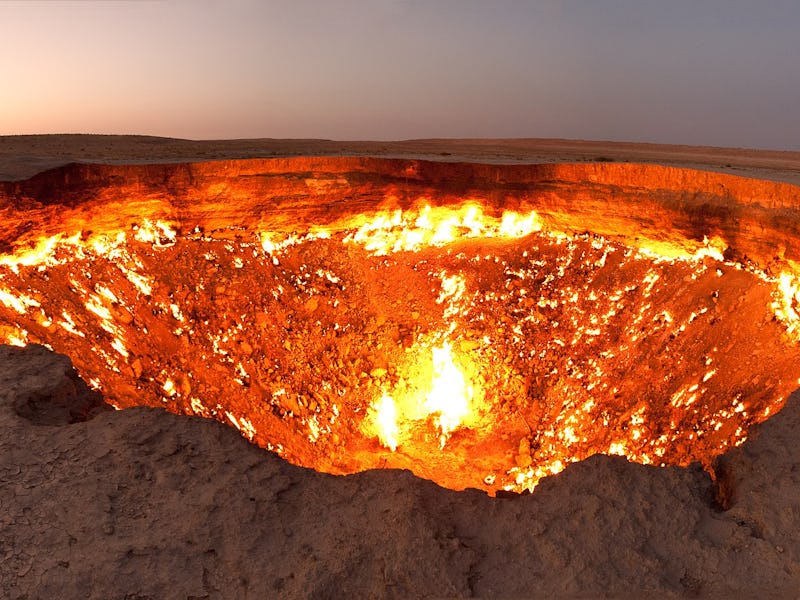The Real 'Gates of Hell' Haven't Stopped Burning For 46 Years
'It’s like something out of a science fiction film.'

Deep in the Karakum Desert is a place so metal that hordes of camel spiders routinely plunge to their deaths into a pit of fire. These unknowing souls are drawn to the flames of the Darvaza gas crater, a blazing pit in Turkmenistan that’s more commonly known as The Gates of Hell. This portal also lures hundreds of tourists every year. After all, what says “vacation” like a remote hellmouth?
There’s no official record of how the Gates of Hell emerged, but the most widely accepted story is that in 1971, when Turkmenistan was a part of the Soviet Union, geologists operating a drilling rig accidentally drilled into a pocket of natural gas. The site caved in, exposing a large crater that began to spew out toxic, methane-infused gas.
Hoping to burn the natural gas away and prevent an environmental catastrophe, the geologists set the craters aflame — and the Gates of Hell haven’t stopped burning since.
A nice travel destination.
The Darvaza gas crater has continued to burn because natural, flammable, gas continues to seep into the crater at, what NASA’s Earth Observatory describes as, “a significant rate”. Methane, an odorless and transparent gas, is found both above the Earth’s surface and below it: It can bubble up from swamps, leak from oil wells, emerge from the farts of cows, and rise up from sewage treatment plants.
The volume of methane released from the Darvaza gas crater is about the same as the amount that goes into a large gas-fired power plant. Its presence shouldn’t come as a surprise: Turkmenistan has the sixth largest natural gas reserve in the world.
The several craters that initially collapsed have turned into one big crater.
In 2013, National Geographic explorer and storm chaser George Kouronis jumped into a heat-reflective suit and a Kevlar climbing harness and became the first person to go on an expedition inside the mouth of Hell, whose opening measures 225 feet wide and 30 meters deep. What he saw, he later told National Geographic in an interview, was an extraordinary place that roared like the sound of a jet engine:
“When you first set eyes on the crater, it’s like something out of a science fiction film. You’ve got this vast, sprawling desert with almost nothing there, and then there’s this gaping, burning pit… The heat coming off of it is scorching. The shimmer from the distortion of it warping the air around it is just amazing to watch, and when you’re downwind, you get this blast of heat that is so intense that you can’t even look straight into the wind.”
During his journey, Kouronis collected soil samples at the bottom of the crater, and subsequent analysis of the samples revealed bacteria. These weren’t just any bacteria — they were extremely heat-resistant species that were not present in the samples of soil collected just outside of the crater. This indicated to the scientists that life can thrive in the most intense of situations — whether it’s a fire pit on Earth, or, perhaps, somewhere outside of our solar system where conditions are similarly extreme. The Gates of Hell could end up becoming a window to understanding how organisms can survive in space, which is a scientific step that even the devil could probably get behind.